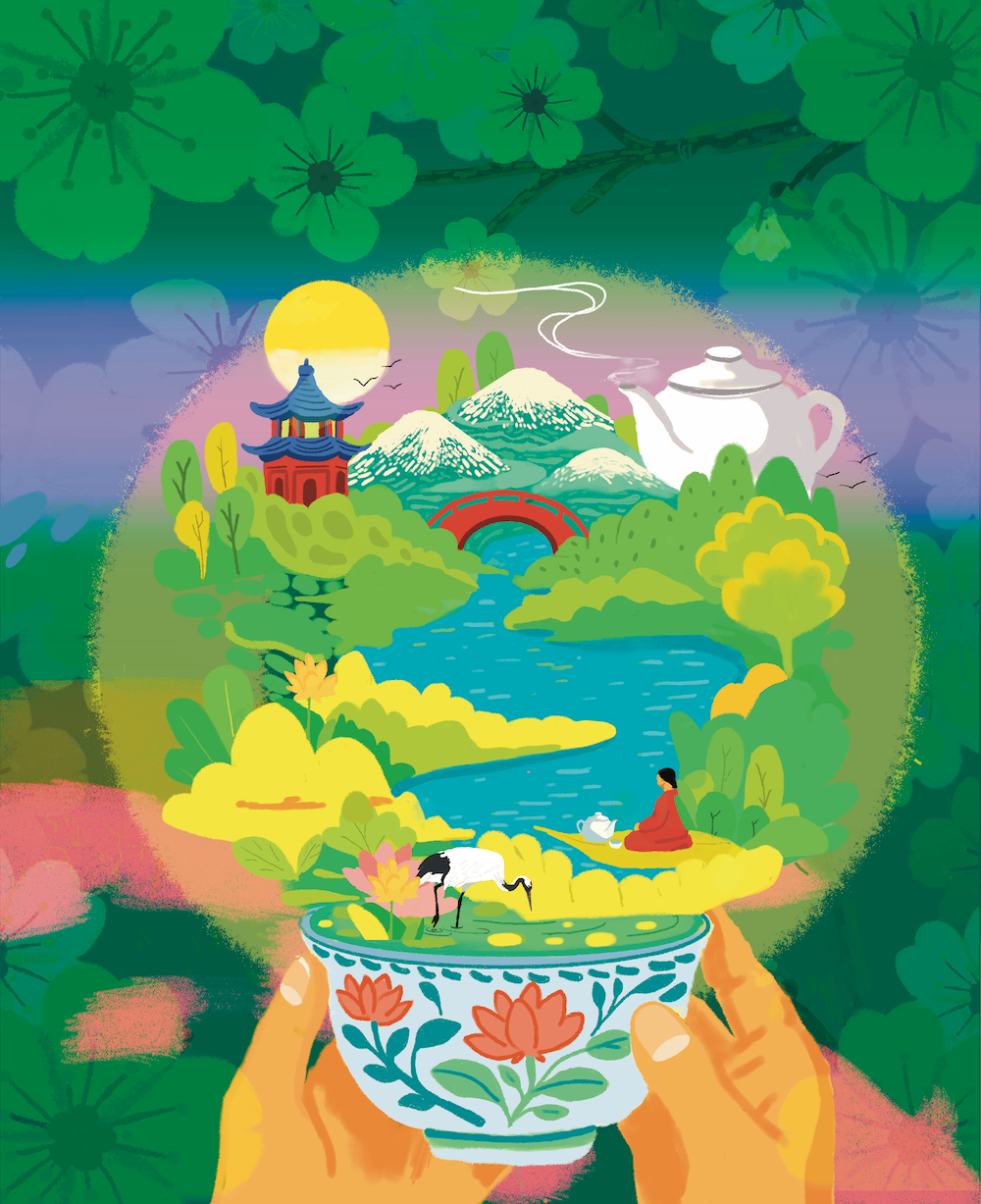Ready for a brew? While you wait for the kettle to boil, why not learn how to recreate the magic of Chinese tea ceremonies…
Whether you prefer calming camomile or a freshly-made builder’s brew, chances are you’ve slurped one of the five billion cups of tea that are consumed globally each day. For us Brits, tea is baked into our everyday culture – serving as a popular alternative to morning java, a much-needed break from the daily grind, or an offering of sympathy to a grieving friend, to name just a few. Our tea-making habits are so predictable that the National Grid is obliged to forecast electricity needs for large events – like World Cups and major TV moments – to avoid service disruption, such as in 2011, when 640,000 kettles boiled across the country as audiences tuned in for the Royal wedding.
But, there is a contemplative approach to tea that you may not be aware of, where every sip is an invitation to slow down and be present. Chinese tea ceremonies – or ‘gong fu cha’ – may not be commonplace in British homes, but they hold untapped wellbeing benefits that are worth exploring.
What is gong fu cha?
There are several different kinds of Chinese tea ceremony, but the most common is the gong fu cha, which translates to ‘making tea with skill’ or ‘tea with effort’. It refers to a Chinese method of tea preparation that emphasises careful brewing techniques and attention to detail. Often misrepresented as a traditional method with ancient origins, records suggest that gong fu cha originates from an 18th century brewing style local to the Chaozhou region of China, which was later popularised in the 1970s, making it into the contemporary Chinese practice we see today.
“The traditional Chinese tea ceremony is a style of brewing that can vary immensely in equipment and resources used, but, essentially, is about hosting guests and serving them an experience, or creating a beautiful experience for yourself,” explains Annelise Bennett, tea specialist and boutique manager at Newby Teas.

“Less formal than a Japanese tea ceremony, gong fu cha is less structured and ritualistic. But, this ceremony is more than just brewing tea, it is a lifestyle encompassing tea that encourages the brewer and their guests to slow down and relish tea, its flavour and context, as well as good company and conversation.”
Hosts will prepare a selection of looseleaf teas, encouraging their guests to connect mindfully with every detail of the ceremony, from boiling the water and rinsing the tea, to warming the cups and serving the perfect pour. Special utensils such as scoops, tongs, clay teapots, and small cups allow the host to skillfully brew tea to the perfect flavour, which is central to the whole experience.
“Gong fu cha is brewed with more tea-to-amount-of-water than more western styles of brewing, and for much less time,” explains Annelise. “This means the leaves retain their taste for multiple steeps, anything from five to 20 steeps. Part of gong fu cha is appreciating how the flavour of the tea changes with each steep.”
More than a quick morning cuppa to get you out the door, gong fu cha is an invitation to slow down and envelop ourselves in the intricate process of making tea, be mindful, and drink with a meditative attitude.
Health benefits of Chinese tea ceremonies
Although the active compounds in tea have been linked to positive effects on depression, anxiety, and sleep disorders, the effects of tea ceremonies on mental health is currently unknown. However, one randomised control trial published in Explore: The Journal of Science & Healing looked at the wellbeing benefits of drinking tea that had been ‘treated’ with good intentions by three Buddhist monks. The results showed that those who believed they were drinking treated tea had a strong positive improvement in mood, suggesting that tea-making as a spiritual practice has potentially therapeutic effects.
Black tea contains flavonoids, which, when consumed on a regular basis may help manage or reduce the likelihood of conditions such as cardiovascular disease, high cholesterol, and high blood pressure. A 2023 poll of 1,000 UK adults, conducted by Perspectus Global, found that middle-aged and older adults think tea is great for hydration and boosting mood, while younger adults drink tea to help ease and relieve stress.
One thing that doesn’t need scientific backing is the idea of tea as a ritual, and this is where the magic happens. “The idea of slowing down and appreciating how far history has come for us to drink tea, as well as how much has had to happen for us to have the tea in front of us today, and appreciating the fortune we have to taste and enjoy the tea, is something that can benefit many people,” says Annelise. “It can help us focus, connect, and practise gratitude.”
. Lavender: soothing, helps sleep
. Lemon: supports digestion and improved
mental clarity
. Camomile: reduces stress and aids sleep
. Peppermint: mood-boosting, aids memory,
reduces anxiety
. Green: improves focus and mood
Anyone for a cuppa?
Here are some tips on how to add some ceremony to your own tea-making rituals:
-
Opt for the best tea you can afford. According to Annelise, high quality tea can be brewed multiple times to release changing flavour, whereas a lesser quality tea will not. “I would recommend Golden Needle for a smooth chocolatey and nutty flavour profile, as well as the Yunnan Silver Needle which has deep herbaceous notes. Typically, Oolongs and Pu Erhs are best for 10+ steeps, and something like Newby’s Wild Flower Oolong changes from delicate floral notes into deeper vegetal flavours as it is brewed.”
-
Elevate your experience with a gaiwan or traditional clay teapot. The porous clay absorbs and improves the flavour of certain blends of tea.
-
Always start by warming up your teapot with boiling water. This will reduce the temperature shift inside the teapot, which can affect the flavour of the tea.
-
Consider rinsing your tea leaves, depending on the blend you’re using. Fermented teas, such as Pu Erh teas, may contain traces of dust, mould, or bacteria. Pour some hot water over your leaves to rinse them, then drain away the water.
-
Refill the teapot with boiled water, cover and leave for a few seconds to preserve the aroma of the tea. Continue to pour hot water over the tea and allow it to brew for the time specified by the manufacturer.
Warm your cups (small ones are traditional) and pour your tea when it is ready. Take a sip and savour the fruits of your labour!

Comments